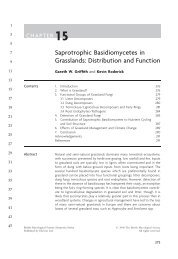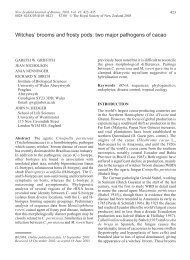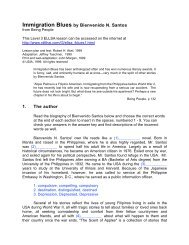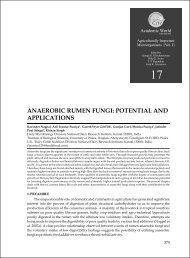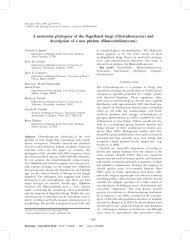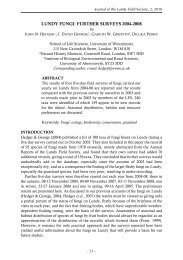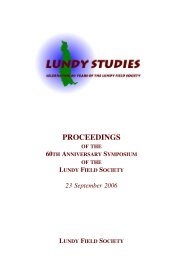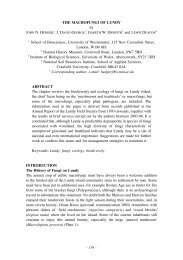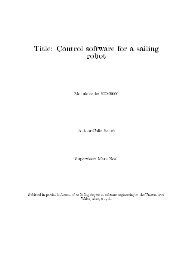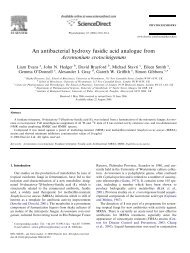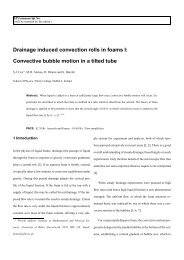Short and long-range visual navigation using warped panoramic ...
Short and long-range visual navigation using warped panoramic ...
Short and long-range visual navigation using warped panoramic ...
Create successful ePaper yourself
Turn your PDF publications into a flip-book with our unique Google optimized e-Paper software.
<strong>Short</strong> <strong>and</strong> <strong>long</strong>-<strong>range</strong> <strong>visual</strong> <strong>navigation</strong><br />
<strong>using</strong> <strong>warped</strong> <strong>panoramic</strong> images<br />
Frédéric Labrosse<br />
Department of Computer Science<br />
University of Wales, Aberystwyth<br />
Aberystwyth SY23 3DB, United Kingdom<br />
e-mail: ffl@aber.ac.uk<br />
This is a preprint of an article published in Robotics <strong>and</strong> Autonomous Systems, 55(9), pp. 675–684, 2007. Published<br />
online at ScienceDirect (www.sciencedirect.com).<br />
Preprint submitted to Robotics <strong>and</strong> Autonomous Systems
<strong>Short</strong> <strong>and</strong> <strong>long</strong>-<strong>range</strong> <strong>visual</strong> <strong>navigation</strong> <strong>using</strong> <strong>warped</strong> <strong>panoramic</strong> images<br />
Abstract<br />
Frédéric Labrosse<br />
Department of Computer Science, University of Wales, Aberystwyth<br />
Aberystwyth, Ceredigion, SY23 3ET, United Kingdom<br />
In this paper, we present a method that uses <strong>panoramic</strong> images to perform <strong>long</strong>-<strong>range</strong> <strong>navigation</strong> as a succession of short-<strong>range</strong><br />
homing steps a<strong>long</strong> a route specified by appearances of the environment of the robot a<strong>long</strong> the route. Our method is different<br />
from others in that it does not extract any features from the images <strong>and</strong> only performs simple image processing operations. The<br />
method does only make weak assumptions about the surroundings of the robot, assumptions that are discussed. Furthermore, the<br />
method uses a technique borrowed from computer graphics to simulate the effect in the images of short translations of the robot to<br />
compute local motion parameters. Finally, the proposed method shows that it is possible to perform <strong>navigation</strong> without explicitly<br />
knowing where the destination is nor where the robot currently is. Results in our Lab are presented that show the performance of<br />
the proposed system.<br />
1. Introduction<br />
Visual <strong>navigation</strong> increasingly relies on local methods:<br />
paths are specified in terms of intermediate targets that<br />
need to be reached in succession to perform the <strong>navigation</strong><br />
task (Vassallo et al., 2002; Neal <strong>and</strong> Labrosse, 2004; Gourichon,<br />
2004). This task can thus be seen as a succession of<br />
homing steps.<br />
Many homing methods that use vision require the extraction<br />
of features from the images <strong>and</strong> their matching<br />
between successive images. This is for example the<br />
case of most methods derived from the snapshot model<br />
(Cartwright <strong>and</strong> Collett, 1983, 1987). A snapshot is a representation<br />
of the environment at the homing position,<br />
often a one-dimensional black <strong>and</strong> white image of l<strong>and</strong>marks<br />
<strong>and</strong> gaps between l<strong>and</strong>marks (Röfer, 1997; Möller<br />
et al., 1999), but also a two-dimensional image of l<strong>and</strong>marks<br />
such as corners (Vardy <strong>and</strong> Oppacher, 2003). Most<br />
of these methods use <strong>panoramic</strong> snapshots.<br />
Although feature extraction can be fast, it often requires<br />
assumptions about the type of features being extracted <strong>and</strong><br />
the world in which the robot is, in particular its structure<br />
(Gonzales-Barbosa <strong>and</strong> Lacroix, 2002). Natural environments<br />
often present no obvious <strong>visual</strong> l<strong>and</strong>marks or when<br />
Email address: ffl@aber.ac.uk (Frédéric Labrosse).<br />
1<br />
these exist, they are not necessarily easy to distinguish from<br />
their surroundings. The matching of features between successive<br />
images is often difficult <strong>and</strong> also requires many assumptions<br />
about the world surrounding the robot <strong>and</strong>/or<br />
the motion of the robot. Even currently widely used feature<br />
extraction methods such as the Harris detector or the Scale<br />
Invariant Feature Transform (SIFT) (Nistér et al., 2006;<br />
Lowe, 2004; Se et al., 2002) require expensive computation<br />
stages. Recently, Stürzl <strong>and</strong> Mallot (2006) have used the<br />
correlation of Fourier transformed 1D <strong>panoramic</strong> images<br />
to compute homing vectors. Although this offers a compact<br />
way of storing snapshots of the world (a few Fourier<br />
coefficients), this introduces additional computation (the<br />
Fourier transform).<br />
We propose to use raw images; this is the appearancebased<br />
approach (Labrosse, 2006; Binding <strong>and</strong> Labrosse,<br />
2006; Neal <strong>and</strong> Labrosse, 2004). Using whole twodimensional<br />
images rather than a few l<strong>and</strong>marks extracted<br />
from images or even 1D images (as in (Stürzl <strong>and</strong> Mallot,<br />
2006)) reduces aliasing problems; indeed, different places<br />
can look similar, especially if “seen” <strong>using</strong> only a few<br />
elements of their appearance.<br />
Only a few authors proposed to use raw images of some<br />
sort, e.g., Röfer (1997); Bisset et al. (2003); Neal <strong>and</strong><br />
Labrosse (2004); Gonzales-Barbosa <strong>and</strong> Lacroix (2002). An
important exception is the work of Zeil et al. (2003), who<br />
systematically studied the changes in <strong>panoramic</strong> images<br />
when the camera was moved in an outdoor environment.<br />
In this paper we address the problem of following a route<br />
in an unmodified environment specified by way-points characterised<br />
by their appearance (way-images). The route is<br />
followed by a succession of homing steps from one wayimage<br />
to the following. The method uses <strong>panoramic</strong> images<br />
captured <strong>using</strong> an omni-directional camera (a “normal”<br />
camera pointing up at a hyperbolic mirror) <strong>and</strong> simple<br />
image processing as well as algorithms borrowed from<br />
computer graphics. An early version of the homing procedure<br />
was proposed in (Binding <strong>and</strong> Labrosse, 2006).<br />
Note that a method implementing the homing stages<br />
was proposed in (Zeil et al., 2003) but implemented in an<br />
unrealistic setting: the robot was not rotating <strong>and</strong> it was<br />
moving a<strong>long</strong> trajectories that were neither efficient nor<br />
possible with a mobile robot (their “robot” was a camera<br />
mounted on a gantry). Similar work <strong>and</strong> methods have<br />
been presented in (Franz et al., 1998; Stürzl <strong>and</strong> Mallot,<br />
2006), the important differences being that (1) they used<br />
1D <strong>panoramic</strong> images, (2) they used features that were<br />
“<strong>warped</strong>” on the 1D image, while we use complete 2D images<br />
without any feature extraction, <strong>and</strong> (3) the matching<br />
between images was done in the Fourier domain, while we<br />
do it in the image space.<br />
Section 2 describes the method used to perform the short<strong>range</strong><br />
step (homing) by first describing what the problem<br />
is <strong>and</strong> our solution to the problem. Section 3 describes our<br />
solution to <strong>long</strong>-<strong>range</strong> <strong>navigation</strong> <strong>and</strong> the overall algorithm.<br />
Section 4 presents some results. A discussion <strong>and</strong> conclusion<br />
are provided in Sections 5 <strong>and</strong> 6.<br />
2. <strong>Short</strong>-<strong>range</strong> <strong>navigation</strong>: the homing step<br />
2.1. The problem<br />
The method relies on the fact that images grabbed by a<br />
moving robot progressively change <strong>and</strong> that there is thus a<br />
clear mapping between images <strong>and</strong> positions of the robot in<br />
its environment. This mapping however can break in some<br />
circumstances, typically when distinct places look similar<br />
(i.e. have the same appearance). In the case of homing, this<br />
is not a problem because the robot starts from a position<br />
that is not too remote from its destination. The mapping is<br />
however made more robust by the use of whole <strong>panoramic</strong><br />
images (Figure 2 gives some examples <strong>and</strong> the procedure<br />
to obtain these images is detailed in (Labrosse, 2006)), not<br />
just features extracted from them.<br />
2<br />
Fig. 1. The distance between images grabbed from a number of<br />
regular positions <strong>and</strong> a target image at the centre of the area<br />
The problem is then to compare images in a way that is<br />
both fast <strong>and</strong> reliable <strong>and</strong> expresses this mapping between<br />
images <strong>and</strong> positions. For this, we compare images <strong>using</strong><br />
a simple pixel-wise method. An h × w pixels image with c<br />
colour components per pixel is a point in the image space, a<br />
space having h × w × c dimensions representing all possible<br />
images of the given size. Images can thus be compared by<br />
measuring the distance between them in that image space.<br />
In this work, for no other reason than simplicity, continuity<br />
<strong>and</strong> smoothness, the Euclidean distance was used. The<br />
distance between two images is thus defined as:<br />
�<br />
�<br />
�<br />
d(Ii, Ij) = � h×w � c�<br />
(Ij(k, l) − Ii(k, l)) 2 , (1)<br />
k=1 l=1<br />
where Ii(k, l) <strong>and</strong> Ij(k, l) are the l th colour component of<br />
the k th pixel of images Ii <strong>and</strong> Ij respectively. Pixels are<br />
enumerated, without loss of generality, in raster order from<br />
top-left corner to bottom-right corner. We used for this<br />
work the RGB (Red-Green-Blue) colour space, thus having<br />
three components per pixel. The combination of Euclidean<br />
distance <strong>and</strong> RGB space is not necessarily the best to use<br />
but it is sufficient for our purposes (see (Labrosse, 2006)<br />
for a discussion).<br />
Figure 1 shows the distance between a number of images<br />
<strong>and</strong> a “target” image, in our Lab. The images were grabbed<br />
from positions on a regular grid (81 images in total) <strong>and</strong> the<br />
target image was grabbed from approximately the centre<br />
of the grid. The grid size in Cartesian space is 4 m × 4 m.<br />
For all the images the robot was facing the same direction.<br />
Images corresponding to positions on Figure 1 around
Fig. 2. Some of the images used for the experiment on Figure 1:<br />
target image (top) <strong>and</strong> positions (3, 3.5) (middle) <strong>and</strong> (0, 0) (bottom)<br />
It<br />
Y<br />
Fig. 3. The four images needed to compute the gradient of the<br />
distance function at a given position<br />
(0, 0) <strong>and</strong> (0, 4) were grabbed while the robot was almost<br />
touching large objects (Figure 2, bottom), hence producing<br />
larger <strong>and</strong> faster varying distance values compared to<br />
other places where the robot was far from any object. This<br />
is consistent with results presented in (Zeil et al., 2003) for<br />
an outdoor environment in a large variety of spatial configurations.<br />
The mapping between distance in image space (comparison<br />
of the images) <strong>and</strong> in Cartesian space (distance to the<br />
target) is clearly visible. In particular it is visible that the<br />
homing position corresponds to the minimum of the distance<br />
as a function of Cartesian space, which in a real situation<br />
is not available. It is also clear that a gradient descent<br />
on this function will lead to the minimum. This however implies<br />
two problems: computing the gradient of the distance<br />
function <strong>and</strong> knowing the orientation of the robot relative<br />
to that of the target (the mapping is indeed not as clear<br />
when the images are grabbed with r<strong>and</strong>om orientations).<br />
Computing the gradient of the distance function at any<br />
point requires four images: the target image It, the current<br />
image Ic <strong>and</strong> two images Iδx <strong>and</strong> Iδy taken after two short<br />
displacements from the current position corresponding to<br />
two orthogonal directions X <strong>and</strong> Y , as shown in Figure 3.<br />
A solution to that problem was proposed by Zeil et al.<br />
(2003): physically moving the robot to obtain the images<br />
Iδx <strong>and</strong> Iδy. However, in the context of mobile robotics this<br />
is not desirable or even possible. It could be argued that<br />
only a small triangular trajectory from the current position<br />
is needed to obtain the three images, but such a trajectory<br />
is difficult to accurately perform in all but contrived cases<br />
<strong>and</strong> is impossible with many robots (but not with the one<br />
Iδy<br />
Ic<br />
X<br />
Iδx<br />
3<br />
we used in this work, although it was used as a car-like<br />
vehicle, making such trajectory indeed difficult to follow).<br />
Moreover, such a procedure would not be efficient, which<br />
is important in many situations.<br />
The problem of knowing the orientation of the robot relative<br />
to that of the target can be solved in a number of ways<br />
(<strong>and</strong> as such has been assumed to be available in many papers).<br />
One solution is to use an additional sensor such as a<br />
magnetic compass. Another is to incorporate the orientation<br />
finding in the process. This is possible to some extent<br />
for example as part of the feature matching process (Möller<br />
et al., 1999) or optical flow computation (Röfer, 1997).<br />
We propose our solution to these two problems in the<br />
next section.<br />
2.2. Our solution<br />
The orientation of the robot can be estimated <strong>using</strong> the<br />
<strong>panoramic</strong> images themselves. This is what we use here.<br />
For each new image grabbed, the change in orientation is<br />
computed by measuring column shifts between the previous<br />
<strong>and</strong> current images (Labrosse, 2006). This procedure<br />
provides the orientation of the robot at each new image<br />
with an error within 20 ◦ after a <strong>long</strong> trajectory. For short<br />
trajectories involved in homing, the typical error is below<br />
5 ◦ , which is of the order of the maximum error the proposed<br />
method can cope with (see (Binding <strong>and</strong> Labrosse, 2006)<br />
for the relevant experiments).<br />
Once the orientation of the robot relative to that of the<br />
target is known, the direction of the two translations needed<br />
for the gradient computation becomes specified.<br />
We propose to simulate the translations by synthesising<br />
the corresponding images from the current image Ic. There<br />
is a large number of papers in the literature on image-based<br />
rendering in general <strong>and</strong> simulation of new viewpoints in<br />
particular. Most of these methods tackle the more general<br />
<strong>and</strong> theoretical problems (Ullman <strong>and</strong> Basri, 1991; Lu<br />
et al., 1998; Tenenbaum, 1998; Shum et al., 2002). In this<br />
paper we adopt a more purposive approach because we are<br />
only interested in simulating specific short displacements:<br />
forward <strong>and</strong> sideways translations.<br />
The environment of the robot projects onto the<br />
<strong>panoramic</strong> images from left to right in the images as the<br />
areas corresponding to the left of the robot (column 1),<br />
the back (column 90), the right (column 180), the front<br />
(column 270) <strong>and</strong> finally the left again (column 360), for<br />
images that are 360 pixels wide, Figure 4. When the robot<br />
moves forward, the part of the image corresponding to the<br />
front of the robot exp<strong>and</strong>s while the part corresponding to
PSfrag replacements<br />
Left Back Right Front Left<br />
Fig. 4. Projection of the environment of the robot onto <strong>panoramic</strong><br />
images<br />
Left Back Right Front Left<br />
Left Back Right Front Left<br />
Fig. 5. Deformations introduced in <strong>panoramic</strong> images by forward<br />
(top) <strong>and</strong> sideways to the right (bottom) translation of the robot<br />
the back contracts. The parts corresponding to the sides<br />
move from front to back, Figure 5. A similar deformation<br />
happens when the robot moves sideways (to the right).<br />
An exact transformation could be computed <strong>using</strong> the<br />
characteristics of the camera, if the 3D structure of the environment<br />
was available. Indeed, the exact apparent motion<br />
of objects in the images depends on their position in<br />
the environment relative to the camera. Since the 3D structure<br />
of the environment is not available, we can only compute<br />
an approximation of the transformation. Moreover,<br />
parts of the environment not visible from the current position<br />
might be visible from the translated position, <strong>and</strong><br />
vice-versa. These occluded parts cannot be recovered by<br />
any transformation of the images.<br />
We perform the transformation by warping the images<br />
<strong>using</strong> bilinear Coons patches (Heckbert, 1994). The method<br />
only needs the boundary of the area of the original images<br />
that need to be transformed into the new rectangular images,<br />
this for both translations. To obtain these boundaries,<br />
the rectangle corresponding to the boundary of the original<br />
images is transformed as follows:<br />
– the top <strong>and</strong> bottom edges of the rectangle are regularly<br />
sampled into a number of positions x (20 in all the experiments<br />
reported here);<br />
– each position is shifted horizontally (sh) <strong>and</strong> vertically<br />
(sv) <strong>using</strong> functions described below;<br />
– the new positions are used as control points for the Coons<br />
patches of the top <strong>and</strong> bottom parts of the boundaries;<br />
– the right <strong>and</strong> left sides are defined by the extremities of<br />
the top <strong>and</strong> bottom edges <strong>and</strong> are straight lines.<br />
The two functions used to shift boundary positions are<br />
4<br />
Table 1<br />
Parameters of the polynomials used for the warping corresponding<br />
to a displacement of the robot of 25 cm<br />
Parameter dh ah dv av<br />
Value 3 3.0 3 1.2<br />
piece-wise polynomials of the form s = ax d . These are characterised<br />
by four parameters: dh <strong>and</strong> dv, <strong>and</strong> ah <strong>and</strong> av<br />
respectively for the degrees <strong>and</strong> amplitudes of the polynomials<br />
used for the horizontal <strong>and</strong> vertical shifts.<br />
The value of the parameters was determined by optimisation<br />
as follows. A number of pairs of images grabbed before<br />
<strong>and</strong> after the short forward displacement to model was<br />
acquired. For each pair, the first image was <strong>warped</strong> <strong>and</strong><br />
compared to the second image <strong>using</strong> Eq. (1) to obtain the<br />
distance between the real <strong>and</strong> simulated images. This distance<br />
was then minimised as a function of the amplitudes<br />
of the polynomials for a <strong>range</strong> of values of the degrees of<br />
the polynomials <strong>and</strong> the overall minimum was kept.<br />
The degrees of the polynomials was not included in the<br />
minimisation because of their discrete nature. Moreover,<br />
because the image re-sampling operations (during acquisition<br />
of the <strong>panoramic</strong> images <strong>and</strong> their warping) are done<br />
without smoothing for efficiency reasons, the distance function<br />
tends to present many flat steps separated by sharp<br />
transitions. This means that the gradient of the function<br />
to minimise is difficult to compute. The minimisation was<br />
therefore done <strong>using</strong> the Nelder-Mead simplex method ∗ because<br />
it does not need the gradient of the minimised function.<br />
This minimisation was performed for a large number<br />
of pairs of images <strong>and</strong> the average values was retained as<br />
the parameters of the warping.<br />
For the experiments reported here, the pairs of images<br />
were taken for a forward displacement of 25 cm <strong>and</strong> the<br />
optimal values obtained are given in Table 1. The degrees<br />
of the polynomials has only very limited effect on the minimum<br />
value obtained during the minimisation <strong>and</strong> on the<br />
performance of the system. The amplitudes of the polynomials<br />
is more critical as it reflects the amount of simulated<br />
translation. The simulated displacement should be small<br />
for the computed discrete gradients to be close to the real<br />
gradient of the distance function between current <strong>and</strong> target<br />
images. A displacement of the order of the displacement<br />
between successive images while the robot moves is<br />
appropriate. In previous work, the parameters were determined<br />
manually <strong>and</strong> proved to simulate a (slightly wrong<br />
<strong>and</strong>) too important displacement, making the estimation<br />
∗ The implementation provided in the GNU Scientific Library was<br />
used (http://www.gnu.org/software/gsl/).
sh<br />
sv<br />
3<br />
0<br />
-3<br />
0<br />
1<br />
0<br />
-1<br />
0<br />
90<br />
90<br />
180<br />
Column index<br />
Fig. 6. The functions used for the horizontal (top) <strong>and</strong> vertical<br />
(bottom) shifts of positions to obtain the top of the boundary used<br />
by the warping to simulate the forward translation. For the bottom<br />
part of the boundary, the same functions were used but inverting<br />
the column index.<br />
180<br />
Forward translation<br />
Right translation<br />
Fig. 7. The boundaries used by the warping to simulate the translations<br />
(solid) that map onto the image (dashed)<br />
Fig. 8. A pair of images used to determine the parameters of the<br />
warping <strong>and</strong> the result of the warping: Ic (top), Iδx (middle) <strong>and</strong> the<br />
simulation I ′ δx of Iδx (bottom). Vertical lines show the alignment of<br />
several features.<br />
of the gradient wrong, especially near the minimum of the<br />
distance between current <strong>and</strong> target images, leading to the<br />
systematic offset reported in (Binding <strong>and</strong> Labrosse, 2006).<br />
Figure 6 shows the resulting functions that were used to<br />
shift the boundary points. The sideways translation functions<br />
are the same as for the forward translation but shifted<br />
column-wise by 90 columns. Figure 7 shows the resulting<br />
boundaries used by the warping.<br />
Figure 8 shows an example of an image pair used to determine<br />
the warping parameters a<strong>long</strong> with the result of the<br />
warping of the first image of the pair. Vertical lines show<br />
the alignment of <strong>visual</strong> features of the images. This clearly<br />
shows that the pixels of the real <strong>and</strong> simulated translations<br />
align properly. Note that because the vertical shift is only<br />
of 1.2 pixels, the effect of this shift is only barely visible<br />
on Figure 7 <strong>and</strong> especially Figure 8. This has however a<br />
definitive impact on the computed gradient.<br />
270<br />
270<br />
360<br />
360<br />
5<br />
Fig. 9. The computed gradient for the images used in Figure 1<br />
Once the images simulating the translation of the robot<br />
can be obtained, the gradient of the distance function in<br />
image space at the current position of the robot can be<br />
computed <strong>using</strong> the current image Ic, the two simulated<br />
images I ′ δx <strong>and</strong> I′ δy <strong>and</strong> the target image It:<br />
Γ = (d(Ic, It) − d(I ′ δx, It), d(Ic, It) − d(I ′ δy, It)), (2)<br />
assuming a unitary displacement. The gradient is a vector<br />
the orientation of which, Θ(Γ), points towards the target. †<br />
The gradient is expressed in the reference system of the<br />
target, by aligning all images with the target, ‡ including any<br />
specific orientation of the target that might not be null.<br />
Figure 9 shows the gradient computed <strong>using</strong> the method<br />
for the images used to compute the distance function in<br />
Figure 1. This shows that the method works in most cases.<br />
A typical failure is visible at the left corners of Figure 9.<br />
These positions correspond to places in the environment<br />
which were changing rapidly as a function of the displacement<br />
of the robot because of the proximity of large objects,<br />
Figure 2 (bottom). This is further discussed in Section 5.<br />
It is interesting to note that, as expected from Figure 1,<br />
the magnitude of the gradient increases dramatically as the<br />
robot gets closer to the target. This will be used to compute<br />
the rotational <strong>and</strong> translational speed of the robot.<br />
Note as well that the computed gradient is much better<br />
around the target than the one presented in (Binding <strong>and</strong><br />
† Actually, the gradient should point away from the target as it<br />
should “indicate” high values of the distance function. However, for<br />
convenience, the opposite value was adopted here.<br />
‡ Note, however, that images need not be explicitly re-aligned. Instead,<br />
a change in pixel indexing is performed for efficiency reasons.<br />
Similarly, the warping is never explicitly performed but pre-computed<br />
<strong>and</strong> saved in lookup tables.
Labrosse, 2006). This is due to the automatic estimation of<br />
the parameters of the warping.<br />
Aligning the robot with the direction provided by the<br />
gradient would therefore make it move towards the target,<br />
without knowing where the target or even the robot are in<br />
Cartesian space. This is used for the homing step performed<br />
in the central loop of the algorithm presented in Figure 10.<br />
3. Long-<strong>range</strong> <strong>navigation</strong>: following way-images<br />
3.1. From short to <strong>long</strong>-<strong>range</strong> <strong>navigation</strong><br />
The homing procedure directs the robot towards the target<br />
following the angle Θ(Γ) of the gradient, from any position<br />
at some distance away from it, withing the limits of<br />
the performance of the controller of the robot.<br />
Achieving <strong>long</strong>-<strong>range</strong> <strong>navigation</strong> is done by making the<br />
robot “home” onto a succession of targets, or way-images.<br />
If the gradient as computed in Section 2.2 was perfect, a<br />
<strong>visual</strong> route would therefore be a linear approximation of<br />
the real desired path.<br />
However, as is visible in Figure 9 (<strong>and</strong> as the results will<br />
show), the computed gradient is not necessarily pointing<br />
directly at the target but rather follows local, possibly narrow,<br />
valleys of the distance function. These narrow valleys<br />
are created by asymmetries of the environment, in particular<br />
sudden changes in appearance created by the proximity<br />
of large objects. This implies that the actual path cannot be<br />
guarantied. However, if the path is critical, more frequent<br />
way-images can be used.<br />
3.2. Route following: the algorithm<br />
The algorithm to follow the succession of way-images<br />
making up the route is detailed in Figure 10. The central<br />
loop constitutes the “homing” step (reaching the next wayimage)<br />
while the outer loop performs the following of the<br />
succession of steps.<br />
As previously stated, the orientation of the robot relative<br />
to that of the target must be known at all times. Using<br />
the <strong>visual</strong> compass (Labrosse, 2006), the orientation of the<br />
robot at the beginning of the process must be available.<br />
This is done by <strong>using</strong> a first way-image at the start of the<br />
route. The robot grabs a first image <strong>and</strong> aligns it with the<br />
way-image to compute its orientation relative to it. This is<br />
done by minimising a function similar to the one shown in<br />
Figure 1 but as a function of the orientation of the robot<br />
rather than its position (Labrosse, 2006). Note that this<br />
6<br />
1: It ← firstWayImage()<br />
2: Ic ← newImage()<br />
3: initialiseOrientation(It,Ic)<br />
2006)<br />
4: while (moreWayImages()) do<br />
// See (Labrosse,<br />
5: It ← nextWayImage()<br />
6: behindWayImage ← false<br />
7: repeat // Homing loop<br />
8: Ic ← newImage()<br />
← forwardWarping(Ic)<br />
9: I ′ 10:<br />
δx<br />
I ′ 11:<br />
δy ← sidewaysWarping(Ic)<br />
Γ ← gradient(It,Ic,I ′ δx ,I′ δy )<br />
12: Θ ′ ← turningAngle()<br />
13: τ ← translationSpeed(Γ)<br />
14: ρ ← rotationSpeed(Θ ′ ,Γ)<br />
15: robot.setSpeed(τ,ρ)<br />
16: if (|Θ ′ | < θt) then<br />
17: behindWayImage ← true<br />
18: end if<br />
19: until (behindWayImage && (|Θ ′ | > θT ))<br />
image reached<br />
// Way-<br />
20: end while<br />
21: alignRobot(It,Ic)<br />
// End of route<br />
Fig. 10. The <strong>visual</strong> route following algorithm<br />
procedure does not need the robot to be precisely located<br />
at the position of the first way-image.<br />
A fixed speed was used all a<strong>long</strong> the trajectory for normal<br />
cruising, i.e. before reaching the last but one way-image.<br />
When not at cruising speed, the magnitude of the gradient,<br />
increasing when approaching a target, was used to set the<br />
translational speed of the robot:<br />
τ = τm/(1 + ||Γ||), (3)<br />
where τm is a multiplicative factor. The speed was<br />
clamped to a maximum value equal to the speed used<br />
during normal cruising. This is implemented in function<br />
translationSpeed().<br />
The angle of the gradient is used to compute the turning<br />
angle Θ ′ as the difference between the gradient direction<br />
<strong>and</strong> the current orientation of the robot. This is then used<br />
to compute the rotational speed. This speed could be a<br />
simple proportion of the turning angle. However, because<br />
the angle of the gradient is not reliable near the target (due<br />
to the sudden change in the distance function at the target),<br />
the rotational speed is set as:<br />
ρ = ρm × Θ ′ /||Γ||, (4)<br />
where ρm is a multiplicative factor. When the robot is far<br />
from the target, the magnitude of the gradient tends to zero<br />
<strong>and</strong> takes high values when nearing the target, values that<br />
can be well above 1.0. In practise, because the magnitude
of the gradient can become very small, but never null, the<br />
rotational speed is clamped to a maximum value to ensure<br />
the robot cannot turn on the spot. This is implemented in<br />
function rotationSpeed().<br />
Determining when a way-image is reached can be done<br />
in a number of ways. For example, as previously noted, the<br />
magnitude of the gradient increases dramatically at the target.<br />
A threshold on the magnitude, or its rate of change, or<br />
on the distance itself could be used. However, such thresholds<br />
are difficult to establish <strong>and</strong> their value depends on a<br />
number of factors such as the pixel values of the images,<br />
themselves depending on many factors (illumination, environment,<br />
etc.).<br />
We have used in (Binding <strong>and</strong> Labrosse, 2006) a sudden<br />
change in gradient orientation to detect the passing of the<br />
target, a method that has been used by others, e.g. Röfer<br />
(1997). However, because the current implementation is<br />
much faster than the previous, such sudden changes don’t<br />
happen anymore in most cases. Instead, we simply keep<br />
track of whether the robot has been behind the way-image<br />
(absolute value of the turning angle less than a threshold<br />
θt with a value of 50 ◦ in all experiments reported here) <strong>and</strong><br />
when this has been the case, then a turning angle becoming<br />
higher than a threshold θT (set to 110 ◦ ) in absolute value<br />
indicates that the robot just passed the target.<br />
At the end of the route, the robot is aligned with the final<br />
way-image by computing the difference in orientation between<br />
the final way-image <strong>and</strong> the current image, as for the<br />
initialisation of the orientation of the robot. Although this<br />
only has a limited value for the route following, this shows<br />
that should the <strong>visual</strong> compass used here drift (Labrosse,<br />
2006), the orientation of the robot could be re-computed<br />
when it passes way-images. This could systematically be<br />
done to detect problems of the system, see Section 5. This<br />
has not been done here.<br />
4. Results<br />
We report a number of experiments performed in our<br />
Lab. The motion tracking system VICON 512 was used<br />
to track the position <strong>and</strong> orientation of the robot during<br />
the experiments to assess the precision, repeatability <strong>and</strong><br />
robustness of the method. All distances are given in metres.<br />
Unless otherwise specified, the maximum speed of the robot<br />
was set to 0.6 m/s, approximately the maximum speed the<br />
robot can achieve, <strong>and</strong> turning rate to 28 ◦ /s. The robot used<br />
was a Pioneer 2DXe equipped with a <strong>panoramic</strong> camera. All<br />
the processing was performed on the on-board computer,<br />
a Pentium III at 800 MHz.<br />
7<br />
2<br />
1<br />
0<br />
-1<br />
-2<br />
-4<br />
-2 0<br />
2<br />
4<br />
Fig. 11. Homing from 18 different initial positions r<strong>and</strong>omly scattered<br />
around the target. The initial <strong>and</strong> final orientations of the robot are<br />
show by short thin lines. The target is marked by a star.<br />
As a rough measure of the cost of the computation, the<br />
system was processing approximately 15 frames per second § ,<br />
which is significantly faster than the slowest of two processing<br />
speeds mentioned in (Stürzl <strong>and</strong> Mallot, 2006), but<br />
on whole 2D images in our case. Finally, maximum speeds<br />
were set such that the robot was not turning on the spot,<br />
therefore approaching a car-like model, apart from during<br />
the final alignment stage.<br />
Often, during the experiments, users of the Lab moved<br />
in view of the camera. This didn’t affect the performance of<br />
the system, mostly because the projection of these people<br />
in the images was small <strong>and</strong> therefore not consequential<br />
when performing the global comparison of the images.<br />
4.1. Homing experiments<br />
We start with a number of homing experiments. The<br />
reader is also directed to the experiments reported in (Binding<br />
<strong>and</strong> Labrosse, 2006).<br />
For the first experiment the target was positioned at the<br />
centre of the play area to assess the performance of the<br />
system when the robot starts from all around the target.<br />
In all cases the robot started with the same orientation as<br />
the target (within approximately 4 ◦ ). Figure 11 shows the<br />
trajectories of the robot for 18 runs. The orientation of the<br />
robot <strong>and</strong> target are shown with short thin lines. The target<br />
is shown as a star.<br />
All final positions are in a rectangle of about 1.5 m ×1 m<br />
roughly centred on the target, compared to starting positions<br />
as far as 4 m away from the target. The final orientation<br />
is within 5 ◦ of the target orientation, which is approximately<br />
the maximum error in initial orientation the<br />
method coped with in an experiment reported in (Binding<br />
§ The frame rate dropped to around 9 fps when the system was getting<br />
VICON information due to the bottleneck of the communication<br />
between the VICON server <strong>and</strong> the robot.
1<br />
0<br />
-1<br />
-2<br />
-2 -1 0<br />
1<br />
2<br />
3<br />
Fig. 12. Homing from 4 different initial positions 5.5 m away from<br />
the target<br />
<strong>and</strong> Labrosse, 2006). This shows a good repeatability of<br />
the method. The performance seems however to be worse<br />
than in (Binding <strong>and</strong> Labrosse, 2006). The starting positions<br />
were however much further away from the target than<br />
before. Moreover, in many cases, the robot finished further<br />
away from the target than it was earlier on its path, as a<br />
few highlighted cases in Figure 11 show. This indicates that<br />
the stopping mechanism is not performing very well. Note<br />
as well that the starting positions at the bottom of Figure<br />
11 were approximately 50 cm away from obstacles <strong>and</strong><br />
with that respect the method performs much better than<br />
in (Binding <strong>and</strong> Labrosse, 2006). Finally, <strong>and</strong> most importantly,<br />
there is no bias in the homing position.<br />
The second experiment shows the performance of the<br />
homing over <strong>long</strong> distances. The target was set up at one<br />
end of the play area <strong>and</strong> the robot started from 4 different<br />
positions about 5.5 m away from the target. Because of the<br />
many local minima of the distance function present over<br />
such <strong>long</strong> distances, the robot did oscillate significantly. In<br />
many cases this was triggering the finishing criterion, which<br />
was therefore not used in this experiment. Rather, the robot<br />
was manually stopped once it passed the target, the final<br />
alignment therefore not being done. Despite the many local<br />
minima, the robot does successfully reach the target with<br />
a maximum distance to the target of about 60 cm.<br />
The third experiment shows the repeatability of the trajectories.<br />
The homing procedure was performed several<br />
times from two different starting positions (with an initial<br />
error within 28 mm in the x direction, 21 mm in the y direction<br />
<strong>and</strong> 1 ◦ ). Figure 13 shows the results of the experiment.<br />
All the trajectories finish less than 25 cm from the target<br />
<strong>and</strong> the largest distance between trajectories is about<br />
25 cm, these for initial positions about 3.5 m away from the<br />
target. This shows good repeatability of the method.<br />
8<br />
1.5<br />
0.5<br />
-0.5<br />
1<br />
0<br />
-1<br />
-1.5<br />
-1<br />
2<br />
1<br />
0<br />
-1<br />
-2<br />
-3<br />
0<br />
1<br />
2 3<br />
Fig. 13. Repeatability of the homing procedure<br />
-2<br />
-1<br />
Fig. 14. Repeatability of the route following (1)<br />
4.2. Route following experiments<br />
Having shown the performance of the homing step, we<br />
now present experiments on the <strong>long</strong>-<strong>range</strong> route following.<br />
The first experiment uses 4 way-images set up as the vertices<br />
of an approximate square, starting from the top left<br />
corner <strong>and</strong> running clock-wise back to the starting position,<br />
the first way-image being also used as the last. The route<br />
was first followed 6 times from roughly the same pose (with<br />
an accuracy similar to the one for the experiment on the<br />
repeatability of the homing). The results are shown in Figure<br />
14. A performance similar to that of the homing stage<br />
is displayed. However, not visible on the figure is the fact<br />
that the way-images were sometimes detected too late. One<br />
such trajectory is highlighted in Figure 14. Although the<br />
system did recover, this produced a significantly different<br />
trajectory.<br />
Figure 15 shows the same way-images but this time with<br />
0<br />
1<br />
2
3<br />
2<br />
1<br />
0<br />
-1<br />
-2<br />
2<br />
1<br />
0<br />
-1<br />
-2<br />
-3<br />
-2<br />
Fig. 15. Repeatability of the route following (2)<br />
-2<br />
0<br />
Fig. 16. Repeatability of the route following on a <strong>long</strong> route<br />
significantly different initial orientations of the robot. This<br />
does lead to very different trajectories, mostly because<br />
again of the late detection of the passing of the way-images.<br />
Despite this, the robot still arrives in the vicinity of the<br />
final way-image with the correct orientation.<br />
The final experiment is a route made of 8 way-images,<br />
is significantly <strong>long</strong>er, used most of the play area <strong>and</strong> was<br />
indeed close to its edges (around 1 m at the bottom of Figure<br />
16). The starting position was around (4, −0.5). Various<br />
speeds <strong>and</strong> turning rates were used (maximum speeds from<br />
0.3 m/s up to 0.6 m/s <strong>and</strong> maximum turning rates from<br />
14 ◦ /s up to 28 ◦ /s, the highest values for both being the values<br />
used for all the other experiments).<br />
As with the previous experiments, the system did<br />
wrongly detect the passing of way-images in a number of<br />
cases. This was particularly the case of way-image 6 (at<br />
position (0.25, −1.5)), which was detected just after pass-<br />
-1<br />
0<br />
2<br />
1<br />
4<br />
9<br />
ing way-image 5. In one case (highlighted in Figure 16),<br />
way-image 5 was detected while moving away from wayimage<br />
6, therefore requiring a sudden change in orientation<br />
to turn towards way-image 6. This triggered the detection<br />
of way-image 6 while the robot was very far from it<br />
(approximately at position (−2.7, −1.4)). Nevertheless,<br />
the system recovered by simply moving onto the following<br />
way-image.<br />
However, it is visible that the accuracy does degrade significantly<br />
as the robot progresses. This is partly due to the<br />
increasing error in the measurement of the robot’s orientation<br />
by the <strong>visual</strong> compass, mostly due to the fact that the<br />
robot was moving close to some objects, which is the worst<br />
situation for the <strong>visual</strong> compass (Labrosse, 2006) <strong>and</strong> for<br />
the estimation of the gradient (Section 2.2). This suggests<br />
that the orientation of the robot should indeed be updated<br />
by aligning the current image with the way-image when its<br />
passing is detected, Section 3.2. This however is not that<br />
obvious, see Section 5.<br />
5. Discussion<br />
All the results show good performance of the <strong>visual</strong> homing<br />
procedure <strong>and</strong> the <strong>long</strong>-<strong>range</strong> <strong>navigation</strong> proposed here.<br />
In particular, good repeatability has been demonstrated.<br />
The method makes a number of assumptions. The first<br />
is that, at least for the final stage of the homing, the robot<br />
must be able to turn on the spot. This is because no trajectory<br />
planning has been incorporated in the procedure<br />
to ensure that the robot arrives at the target with the correct<br />
orientation. This is obviously a problem that needs<br />
to be solved should the method be applied to a car-like<br />
robot. However, reaching the correct orientation at each<br />
way-image is not necessarily important <strong>and</strong> correct orientation<br />
could be easily reached for the final target by specifying<br />
a number of close sub-way-images just before the end<br />
of the route. Smoothing the trajectories could however be<br />
beneficial to ensure smooth transitions between segments<br />
of trajectories at the passing of way-images. This moreover<br />
might help solving the detection of this passing. This is still<br />
work in progress.<br />
The second assumption made by the method is that the<br />
same parameters of the warping used to simulate the translation<br />
of the robot for the gradient computation are suitable<br />
in all situations. This is obviously wrong. For example,<br />
the apparent motion of the objects in the images is more<br />
important for objects that are close to the robot than for<br />
far away objects. In other words, we use the “equal distance<br />
assumption” that others have also used (Franz et al., 1998):
the robot is at the centre of a circular arena! However, the<br />
parameters used in these experiments have been obtained<br />
in an environment that was different (objects placed differently<br />
around the play area) <strong>and</strong> for positions that were different<br />
than the positions used in the reported experiments.<br />
Despite this, the performance shown is good.<br />
It is also not clear whether the warping should be symmetrical<br />
for the front <strong>and</strong> back <strong>and</strong> for the right <strong>and</strong> left<br />
because environments are usually not symmetrical around<br />
the robot. This possibly means that the actual directions<br />
of the simulated translations should probably be such that<br />
they align with <strong>visual</strong> symmetries of the environment. Such<br />
symmetries are however difficult to establish.<br />
Because way-images can be in very different locations<br />
for <strong>long</strong>-<strong>range</strong> <strong>navigation</strong>, establishing parameters on a per<br />
way-image basis might be a good idea. This could be done<br />
automatically from real images grabbed after a short (forward)<br />
translation from the way-image, for example when<br />
the route is saved by the robot during a tele-operated first<br />
trip. However, automatically determining the parameters<br />
of the sideways translation, if they need to be different from<br />
that of the forward translation, might be a problem as many<br />
robots cannot reliably perform that translation.<br />
The third assumption is that the way-images can still be<br />
obtained, which is not necessarily the case. For example<br />
if the illumination is not constant in time, then images<br />
grabbed during the route following will often not match the<br />
way-images <strong>and</strong> the performance will decrease. It is however<br />
possible to solve such problems by <strong>using</strong> different colour<br />
spaces (Woodl<strong>and</strong> <strong>and</strong> Labrosse, 2005) <strong>and</strong> <strong>using</strong> shadow<br />
removal or colour constancy methods (Funt et al., 1992;<br />
Finlayson et al., 1993; Barnard <strong>and</strong> Funt, 1998). Moreover,<br />
it has been show that the combination of Euclidean distance<br />
<strong>and</strong> RGB colour space is far from optimal (Labrosse, 2006).<br />
This is an issue that still needs to be addressed.<br />
More difficult to solve is the problem that the environment<br />
of the robot might have changed between the acquisition<br />
of the way-images <strong>and</strong> the route following. The system<br />
is already robust to temporary changes in the current<br />
appearance of the environment if these are not too significant.<br />
This is partly because of the projection geometry of<br />
the camera <strong>and</strong> the global nature of the image comparison,<br />
partly because temporally short glitches do not affect<br />
the system much. To cope with the stability of the wayimages,<br />
it might be possible to replace single way-images<br />
by several that would represent the variations of the appearance<br />
of the environment at the corresponding position.<br />
Methods such as the ones described by Neal <strong>and</strong> Labrosse<br />
(2004) or Nehmzow <strong>and</strong> Vieira Neto (2006) might be useful<br />
10<br />
in that context. This would however imply more expensive<br />
processing. More work is needed in that area.<br />
Another improvement, as discussed above, might be to<br />
re-align the <strong>visual</strong> compass with way-images when they<br />
are passed by. This would reduce the drift of the <strong>visual</strong><br />
compass <strong>and</strong>/or would allow the detection of decreasing<br />
performance. The problem is that if the robot passes (or<br />
at least detects that it passes) a way-image while in fact<br />
it is far from it, then the alignment of the current image<br />
with the way-image is error-prone because of parallax error<br />
(Labrosse, 2006). Doing so would therefore introduce wrong<br />
corrections that might not have been needed.<br />
Finally, the automatic creation of the <strong>visual</strong> routes could<br />
also be important, in particular in the context of Simultaneous<br />
Localisation And Mapping (SLAM). We have already<br />
proposed methods to build topological maps (Neal<br />
<strong>and</strong> Labrosse, 2004) but more needs to be done, in particular<br />
taking into account the characteristics of the <strong>navigation</strong><br />
system.<br />
6. Conclusion<br />
We have described a method that uses simple 2D<br />
<strong>panoramic</strong> image comparisons <strong>and</strong> techniques borrowed<br />
from computer graphics to perform <strong>visual</strong> homing <strong>and</strong><br />
<strong>long</strong>-<strong>range</strong> <strong>navigation</strong> as a succession of homing steps.<br />
The performance of the method has been evaluated in a<br />
number of situations in our Lab <strong>and</strong> shown to be good. A<br />
significant contribution of the work is to show that <strong>navigation</strong><br />
to a specified place in Cartesian space is possible<br />
without knowing where the place is nor even where the<br />
robot is. This has obvious applications, in particular in the<br />
area of exploration <strong>and</strong> map building. Finally, the method<br />
is fast <strong>and</strong> usually recovers from its own failures.<br />
Acknowledgement<br />
The equipment used for this work was partly funded by<br />
HEFCW Science Research Investment Fund (SRIF) grants<br />
from 1999 (for the VICON system) <strong>and</strong> 2002 (for the research<br />
Lab <strong>and</strong> the robotic equipment).<br />
References<br />
Barnard, K., Funt, B., 1998. Experiments in sensor<br />
sharpening for color constancy. In: Proceedings of the<br />
IS&T/SID Sixth Color Imaging Conference: Color Science,<br />
Systems <strong>and</strong> Applications.
Binding, D., Labrosse, F., 2006. Visual local <strong>navigation</strong><br />
<strong>using</strong> <strong>warped</strong> <strong>panoramic</strong> images. In: Proceedings of Towards<br />
Autonomous Robotic Systems. University of Surrey,<br />
Guildford, UK, pp. 19–26.<br />
Bisset, D. L., Aldred, M. D., Wiseman, S. J., 2003.<br />
Light detection apparatus. United States Patent<br />
US 6,590,222 B1, also UK Patent GB 2 344 884 A, 2000.<br />
Cartwright, B. A., Collett, T. S., 1983. L<strong>and</strong>mark learning<br />
in bees: experiments <strong>and</strong> models. Journal of Comparative<br />
Physiology 151, 521–543.<br />
Cartwright, B. A., Collett, T. S., 1987. L<strong>and</strong>mark maps for<br />
honeybees. Biological Cybernetics 57 (1/2), 85–93.<br />
Finlayson, G. D., Drew, M. S., Funt, B. V., 1993. Diagonal<br />
transforms suffice for color constancy. In: Proceedings of<br />
the International Conference on Computer Vision. pp.<br />
164–171.<br />
Franz, M. O., Schölkopf, B., Mallot, H. A., Bülthoff, H. H.,<br />
1998. Where did I take that snapshot? Scene-based homing<br />
by image matching. Biological Cybernetics 79, 191–<br />
202.<br />
Funt, B. V., Drew, M. S., Brockington, M., 1992. Recovering<br />
shading from color images. In: Proceedings of the<br />
European Conference on Computer Vision. pp. 124–132.<br />
Gonzales-Barbosa, J.-J., Lacroix, S., 2002. Rover localization<br />
in natural environments by indexing <strong>panoramic</strong> images.<br />
In: Proceedings of the IEEE International Conference<br />
on Robotics <strong>and</strong> Automation. Washington, USA,<br />
pp. 1365–1370.<br />
Gourichon, S., 2004. Utilisation d’un compas visuel pour<br />
la <strong>navigation</strong> d’un robot mobile. Ph.D. thesis, Université<br />
Paris VI, Paris, France.<br />
Heckbert, P. S., 1994. Bilinear Coons patch image warping.<br />
In: Graphics Gems IV. Academic Press, pp. 438–446.<br />
Labrosse, F., 2006. The <strong>visual</strong> compass: Performance <strong>and</strong><br />
limitations of an appearance-based method. Journal of<br />
Field Robotics 23 (10), 913–941.<br />
Lowe, D. G., 2004. Distinctive image features from scaleinvariant<br />
keypoints. International Journal of Computer<br />
Vision 60 (2), 91–110.<br />
Lu, H.-m., Fainman, Y., Hecht-Nielsen, R., 1998. Image<br />
manifolds. In: Proceedings of SPIE; Applications of Artificial<br />
Neural Networks in Image Processing III. Vol. 3307.<br />
San Jose, CA, USA, pp. 52–63.<br />
Möller, R., Maris, M., Lambrinos, D., 1999. A neural model<br />
of l<strong>and</strong>mark <strong>navigation</strong> in insects. Neurocomputing 26–<br />
27, 801–808.<br />
Neal, M., Labrosse, F., 2004. Rotation-invariant appearance<br />
based maps for robot <strong>navigation</strong> <strong>using</strong> an artificial<br />
immune network algorithm. In: Proceedings of the<br />
11<br />
Congress on Evolutionary Computation. Vol. 1. Portl<strong>and</strong>,<br />
Oregon, USA, pp. 863–870.<br />
Nehmzow, U., Vieira Neto, H., 2006. Visual attention <strong>and</strong><br />
novelty detection: Experiments with automatic scale selection.<br />
In: Proceedings of Towards Autonomous Robotic<br />
Systems. University of Surrey, Guildford, UK, pp. 139–<br />
146.<br />
Nistér, D., Naroditsky, O., Bergen, J., 2006. Visual odometry<br />
for ground vehicle applications. Journal of Field<br />
Robotics 23 (1).<br />
Röfer, T., 1997. Controlling a wheelchair with image-based<br />
homing. In: Proceedings of the AISB Symposium on Spatial<br />
Reasoning in Mobile Robots <strong>and</strong> Animals. Manchester<br />
University, UK.<br />
Se, S., Lowe, D., Little, J., 2002. Mobile robot localization<br />
<strong>and</strong> mapping with uncertainty <strong>using</strong> scale-invariant <strong>visual</strong><br />
l<strong>and</strong>marks. International Journal of Robotics Research<br />
21 (8), 735–758.<br />
Shum, H.-Y., Wang, L., Chai, J.-X., Tong, X., 2002. Rendering<br />
by manifold hopping. International Journal of<br />
Computer Vision 50 (2), 185–201.<br />
Stürzl, W., Mallot, H. L., 2006. Efficient <strong>visual</strong> homing<br />
based on Fourier transformed <strong>panoramic</strong> images. Journal<br />
of Robotics <strong>and</strong> Autonomous Systems 54 (4), 300–313.<br />
Tenenbaum, J. B., 1998. Mapping a manifold of perceptual<br />
observations. Advances in Neural Information Processing<br />
Systems (10).<br />
Ullman, S., Basri, R., 1991. Recognition by linear combination<br />
of models. IEEE Transactions on Pattern Analysis<br />
<strong>and</strong> Machine Intelligence 13 (10), 992–1006.<br />
Vardy, A., Oppacher, F., 2003. Low-level <strong>visual</strong> homing. In:<br />
Advances in Artificial Life: Proceedings of the European<br />
Conference on Artificial Life.<br />
Vassallo, R. F., Santos-Victor, J., Schneebeli, H. J., 2002.<br />
Using motor representations for topological mapping <strong>and</strong><br />
<strong>navigation</strong>. In: Proceedings of the International Conference<br />
on Intelligent Robots <strong>and</strong> Systems. Lausanne,<br />
Switzerl<strong>and</strong>, pp. 478–483.<br />
Woodl<strong>and</strong>, A., Labrosse, F., 2005. On the separation of luminance<br />
from colour in images. In: Proceedings of the<br />
International Conference on Vision, Video, <strong>and</strong> Graphics.<br />
University of Edinburgh, UK, pp. 29–36.<br />
Zeil, J., Hofmann, M. I., Chahl, J. S., 2003. Catchment<br />
areas of <strong>panoramic</strong> snapshots in outdoor scenes. Journal<br />
of the Optical Society of America A 20 (3), 450–469.



